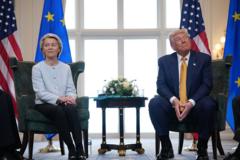As the EU and US celebrate their newly announced trade deal, European leaders are growing increasingly unsettled about what it truly entails. While the agreement avoided imposing a 30% tariff threatened by President Trump, the new 15% tariff on many EU exports has raised eyebrows, with skeptics highlighting that significant discrepancies remain between the two sides about critical sectors.
After months of negotiating, European Commission chief Ursula von der Leyen and President Trump announced the agreement, but the immediate relief felt across Europe has been tempered by disappointment. Many European leaders wished for a stronger negotiating position and are left questioning the overall framework of the deal.
Germany's finance minister, Lars Klingbeil, acknowledged that the agreement brought much-desired stability, despite admitting he would have preferred different terms. The absence of a legally binding document, with the EU Commission indicating it as a set of political commitments, further complicates matters. Olof Gill, a Commission spokesperson, pointed out that additional negotiations are required to refine the agreement.
Differences between the partners create confusion. While US reports assert that pharmaceuticals and semiconductors will incur a 15% tariff, the EU contends these sectors will maintain a 0% rate until global tariff levels are determined. On matters like steel and aluminum, the US plans to keep current rates while negotiations to replace them with a quota system continue.
The language in each side's statements also raises eyebrows. The US claims the EU “will” purchase substantial amounts of energy products from the US, while the EU insists it “intends” to do so, reflecting uncertainty in commitments. Furthermore, projections for investments and defense procurement appear overly optimistic, as many sectors remain constrained by market dynamics and existing commitments.
With key countries facing differing impacts from the new tariffs, German automotive sectors, Irish pharmaceuticals, and Italian agriculture might suffer considerably. Germany relies on the US for 13% of its car exports, while Irish pharmaceuticals represent a substantial US market footprint. As Italy braces for potential GDP losses, trade associations are already demanding EU compensation.
European leaders, like French President Emmanuel Macron, are urging a firmer approach to negotiations moving forward. The present sentiment among various EU officials is clear: they may need to demonstrate a resilient stance in future talks to protect their interests. Ultimately, while the current trade deal brings some predictability, its unresolved issues signal that this is just the beginning of a longer negotiation process.


















